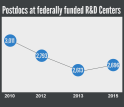News Release 16-134
After two-year decline, postdoc employment at federally funded labs increases
2015 number still below peak employment, but signals rebound after losses

Employment at an FFRDC like Lawrence Livermore National Lab provides valuable postdoctoral training.
October 20, 2016
This material is available primarily for archival purposes. Telephone numbers or other contact information may be out of date; please see current contact information at media contacts.
The number of postdoctoral researchers employed at federally funded research and development centers (FFRDCs) rose to 2,696 in 2015, the first increase seen after two consecutive years of declines, according to a new report from the National Center for Science and Engineering Statistics (NCSES).
The total is higher than the previous survey year's 2,613, although still lower than the peak of 3,011 reported in 2010. Postdoctoral researchers, or postdocs, are individuals who hold doctoral degrees and are engaged in research intended to further their education and experience. Postdocs are a vital part of the nation's next generation of scientists and engineers, and employment at FFRDCs provides them with valuable training opportunities.
The share of postdocs on temporary visas at FFRDCs has decreased over the past decade, going from 61.5 percent in 2005 to 53.8 percent in 2015. However, FFRDCs still employ more postdocs with temporary visas than with U.S. citizenship or permanent resident visas - 1,450 versus 1,246.
Men still make up the majority of postdocs at FFRDCs, although the share of women has increased from 21 percent in 2005 to 24 percent in 2015.
Postdocs in FFRDCs performed research in a wide range of fields in 2015, including:
- Physics and astronomy (28 percent of total postdocs)
- Engineering fields (25 percent)
- Chemistry (16 percent)
- Materials and metallurgical engineering (8 percent)
In 2015, 24 of the 42 FFRDCs employed postdocs. Two of them -- Lincoln Laboratory and Project Air Force -- reported opening new postdoc programs that year.
For more information, including the number of postdocs employed at each FFRDC and a detailed list of postdoc fields of research, read the full report.
-NSF-
-
The number of postdoctoral researchers at FFRDCs peaked in 2010, declined, then rose again in 2015.
Credit and Larger Version
Media Contacts
Rob Margetta, NSF, (703) 292-2663, email: rmargett@nsf.gov
Program Contacts
Kelly H. Kang, NSF, (703) 292-7796, email: kkang@nsf.gov
The U.S. National Science Foundation propels the nation forward by advancing fundamental research in all fields of science and engineering. NSF supports research and people by providing facilities, instruments and funding to support their ingenuity and sustain the U.S. as a global leader in research and innovation. With a fiscal year 2023 budget of $9.5 billion, NSF funds reach all 50 states through grants to nearly 2,000 colleges, universities and institutions. Each year, NSF receives more than 40,000 competitive proposals and makes about 11,000 new awards. Those awards include support for cooperative research with industry, Arctic and Antarctic research and operations, and U.S. participation in international scientific efforts.
Connect with us online
NSF website: nsf.gov
NSF News: nsf.gov/news
For News Media: nsf.gov/news/newsroom
Statistics: nsf.gov/statistics/
Awards database: nsf.gov/awardsearch/
Follow us on social
Twitter: twitter.com/NSF
Facebook: facebook.com/US.NSF
Instagram: instagram.com/nsfgov



